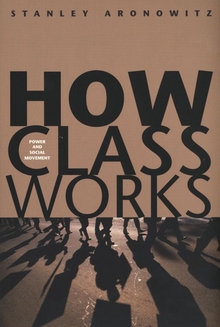How Class Works
WARNING
You are viewing an older version of the Yalebooks website. Please visit out new website with more updated information and a better user experience: https://www.yalebooks.com
Power and Social Movement
Stanley Aronowitz
Although Americans like to believe that they live in a classless society, Stanley Aronowitz demonstrates that class remains a potent force. Defining class as the power of social groups to make a difference, he explains that social groups such as labor movements, environmental activists, and feminists become classes when they make demands that change the course of history.
“With How Class Works Aronowitz puts the subject of social class squarely on the intellectual agenda—though in a new, inclusive, and dynamic form. Like his influential False Promises, How Class Works is both intellectually exciting and morally challenging.”—Barbara Ehrenreich
“In How Class Works Aronowitz argues for the enduring vitality of the concept of social class as a way of understanding social relations. This is a significant contribution to social theory, an argument certain to be widely considered, debated, and tested.”—George Lipsitz, author of American Studies in a Moment of Danger
“An intellectually captivating book on a topic that remains as timely and significant as ever.”—Howard Kimeldorf, University of Michigan
“With How Class Works Aronowitz puts the subject of social class squarely on the intellectual agenda—though in a new, inclusive, and dynamic form. Like his influential False Promises, How Class Works is both intellectually exciting and morally challenging.”—Barbara Ehrenreich
“In How Class Works Aronowitz argues for the enduring vitality of the concept of social class as a way of understanding social relations. This is a significant contribution to social theory, an argument certain to be widely considered, debated, and tested.”—George Lipsitz, author of American Studies in a Moment of Danger
“An intellectually captivating book on a topic that remains as timely and significant as ever.”—Howard Kimeldorf, University of Michigan
Stanley Aronowitz is Distinguished Professor of Sociology at the Graduate Center of the City University of New York.
“In How Class Works, Aronowitz argues for the enduring vitality of the concept of social class as a way of understanding social relations. This is a significant contribution to social theory, an argument certain to be widely considered, debated, and tested.”—George Lipsitz, author of American Studies in a Moment of Danger
“Few scholars have the erudition or the courage to tackle such an expansive set of issues. We are fortunate that Aronowitz has both. He has produced an intellectually captivating book on a topic that remains as timely and significant as ever.”—Howard Kimeldorf, University of Michigan
“This splendid, scholarly, yet highly readable analysis focuses primarily on social class formations and movements in the U.S. Aronowitz writes a critical and impassioned brand of sociology reminiscent of the brilliant radical C. Wright Mills. . . . [He] writes with apparent authority, and the book is filled with rich and relevant substantive, historical, and even philosophical materials. . . . This work is highly current, having been completed after the events of 9/11. Highly recommended.”—Choice
“Once again Stanley Aronowitz has shaken up our complacent notions about social reality, and challenged his readers with a provocative reflection on past, present, and future popular movements for change. Whether one agrees with Aronowitz or not, there is something worth thinking about on every page of this, his newest, book.”—Phil Nicholson, Long Island Newsletter
“With this book Aronowitz puts the subject of social class squarely on the intellectual agenda—though in a new, inclusive, and dynamic form. Like his influential False Promises, How Class Works is both intellectually exciting and morally challenging.”—Barbara Ehrenreich
Selected by Choice Magazine as an Outstanding Academic Title for 2005
ISBN: 9780300105049
Publication Date: July 11, 2004
Publication Date: July 11, 2004
272 pages, 6 1/8 x 9 1/4








